
FastAPI framework, high performance, easy to learn, fast to code, ready for production
--- **Documentation**: [https://fastapi.tiangolo.com](https://fastapi.tiangolo.com) **Source Code**: [https://github.com/tiangolo/fastapi](https://github.com/tiangolo/fastapi) --- FastAPI is a modern, fast (high-performance), web framework for building APIs with Python 3.6+. The key features are: * **Fast**: Very high performance, on par with **NodeJS** and **Go** (thanks to Starlette and Pydantic). * **Fast to code**: Increase the speed to develop features by about 200% to 300% *. * **Less bugs**: Reduce about 40% of human (developer) induced errors. * * **Intuitive**: Great editor support. Completion everywhere. Less time debugging. * **Easy**: Designed to be easy to use and learn. Less time reading docs. * **Short**: Minimize code duplication. Multiple features from each parameter declaration. Less bugs. * **Robust**: Get production-ready code. With automatic interactive documentation. * **Standards-based**: Based on (and fully compatible with) the open standards for APIs: OpenAPI and JSON Schema. * estimation based on tests on an internal development team, building production applications. ## Requirements Python 3.6+ FastAPI stands on the shoulders of giants: * Starlette for the web parts. * Pydantic for the data parts. ## Installation ```bash $ pip install fastapi ``` You will also need an ASGI server, for production such as uvicorn. ```bash $ pip install uvicorn ``` ## Example * Create a file `main.py` with: ```Python from fastapi import FastAPI app = FastAPI() @app.get('/') def read_root(): return {'hello': 'world'} ``` Or if your code uses `async` / `await`, use `async def`: ```Python hl_lines="6" from fastapi import FastAPI app = FastAPI() @app.get('/') async def read_root(): return {'hello': 'world'} ``` !!! note If you don't know, check the section about [`async` and `await` in the docs](async.md). * Run the server with: ```bash uvicorn main:app --debug ``` !!! note The command `uvicorn main:app` refers to: * `main`: the file `main.py` (the Python "module"). * `app`: the object created inside of `main.py` with the line `app = FastAPI()`. * `--debug`: make the server restart after code changes. Only do this for development. ### Check it Open your browser at http://127.0.0.1:8000. You will see the JSON response as: ```JSON {"hello": "world"} ``` ### Interactive API docs Now go to http://127.0.0.1:8000/docs. You will see the automatic interactive API documentation (provided by Swagger UI): 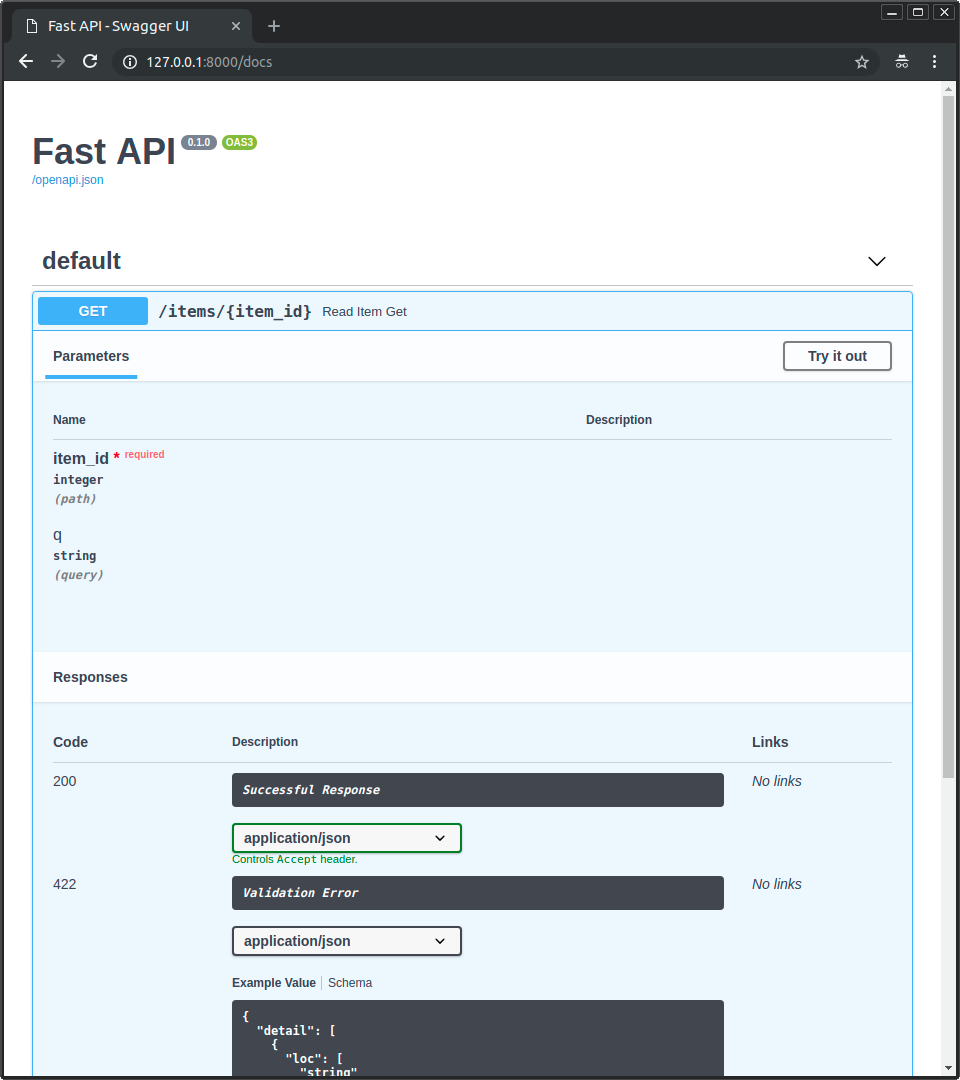 ### Alternative API docs And now, go to http://127.0.0.1:8000/redoc. You will see the alternative automatic documentation (provided by ReDoc): 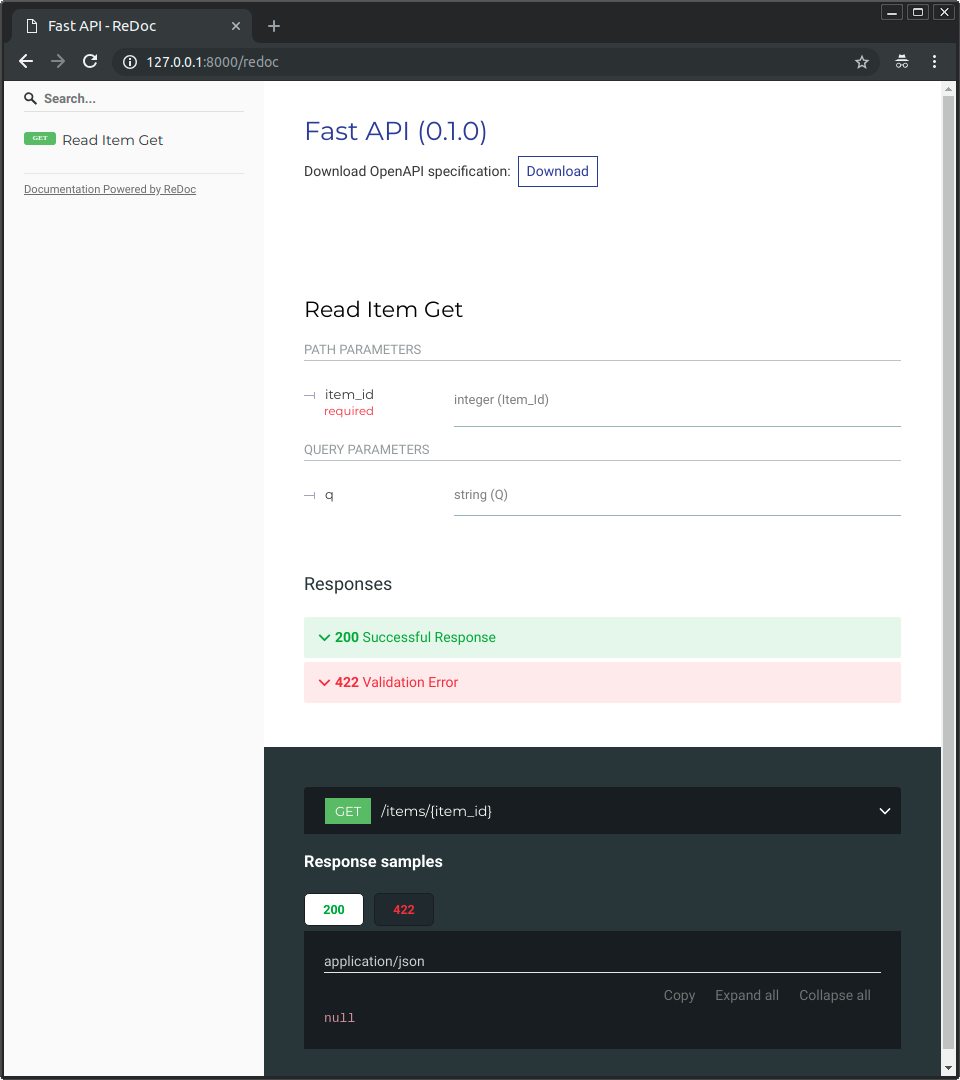 ## Example upgrade Now modify the file `main.py` to include: * a path parameter `item_id`. * a body, declared using standard Python types (thanks to Pydantic). * an optional query parameter `q`. ```Python hl_lines="2 7 8 9 10 19" from fastapi import FastAPI from pydantic import BaseModel app = FastAPI() class Item(BaseModel): name: str price: float is_offer: bool = None @app.get('/') async def read_root(): return {'hello': 'world'} @app.post('/items/{item_id}') async def create_item(item_id: int, item: Item, q: str = None): return {"item_name": item.name, "item_id": item_id, "query": q} ``` The server should reload automatically (because you added `--debug` to the `uvicorn` command above). ### Interactive API docs upgrade Now go to http://127.0.0.1:8000/docs. * The interactive API documentation will be automatically updated, including the new query, and body: 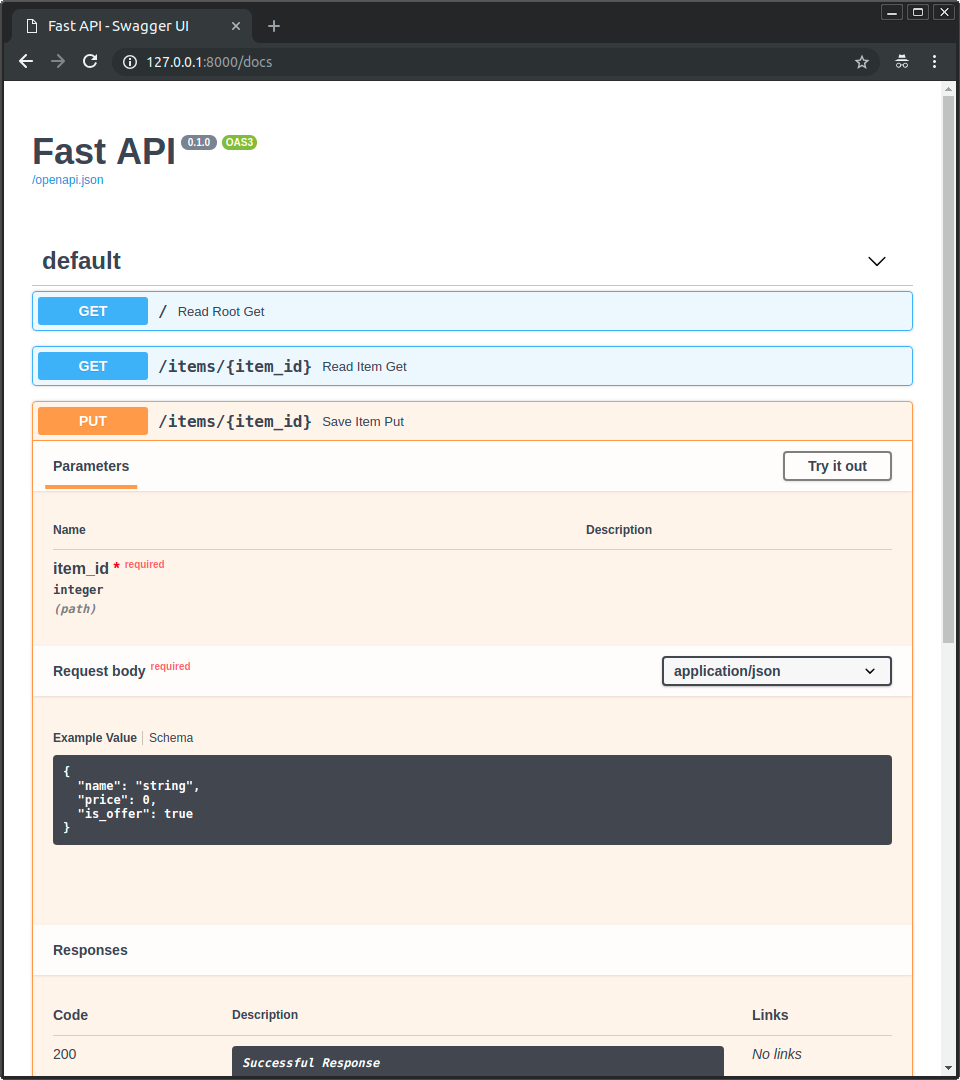 * Click on the button "Try it out", it allows you to fill the parameters and directly interact with the API: 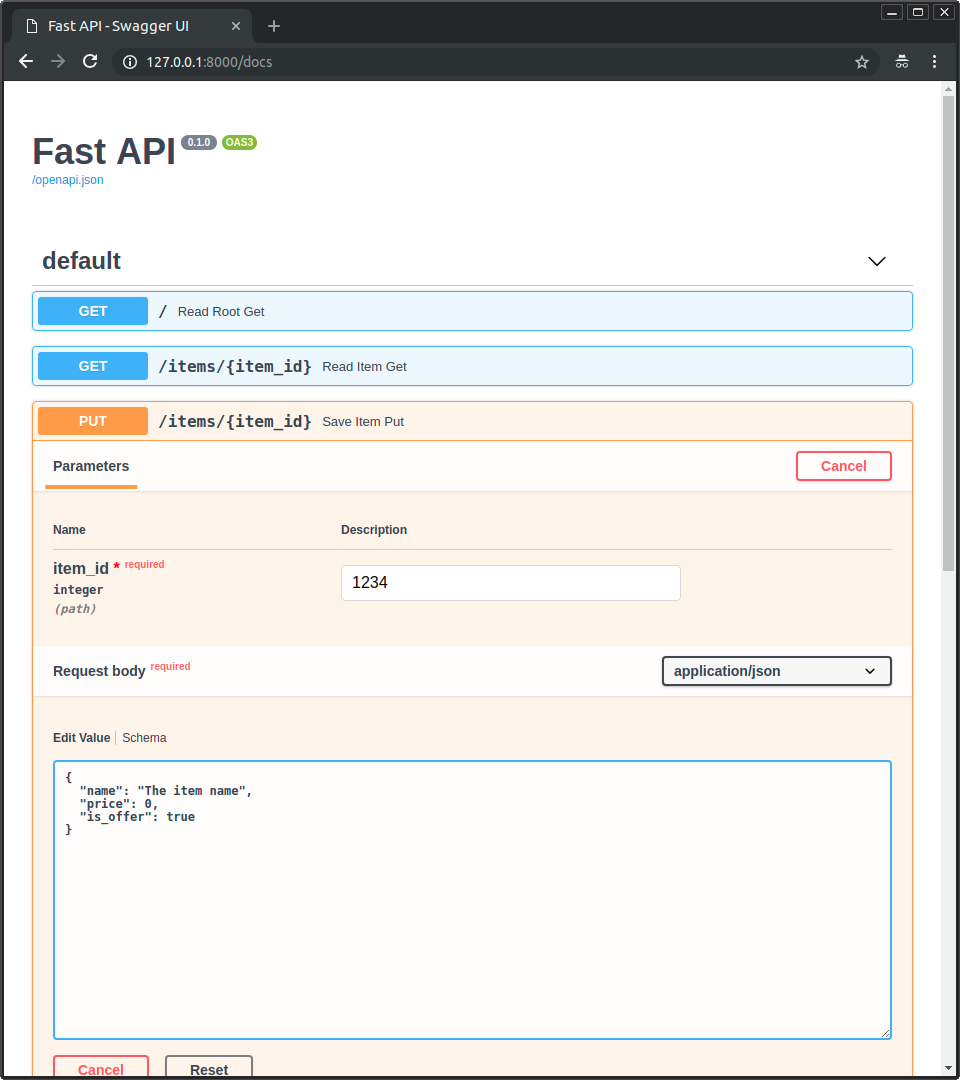 * Then click on the "Execute" button, the user interface will communicate with your API, send the parameters, get the results and show them on the screen: 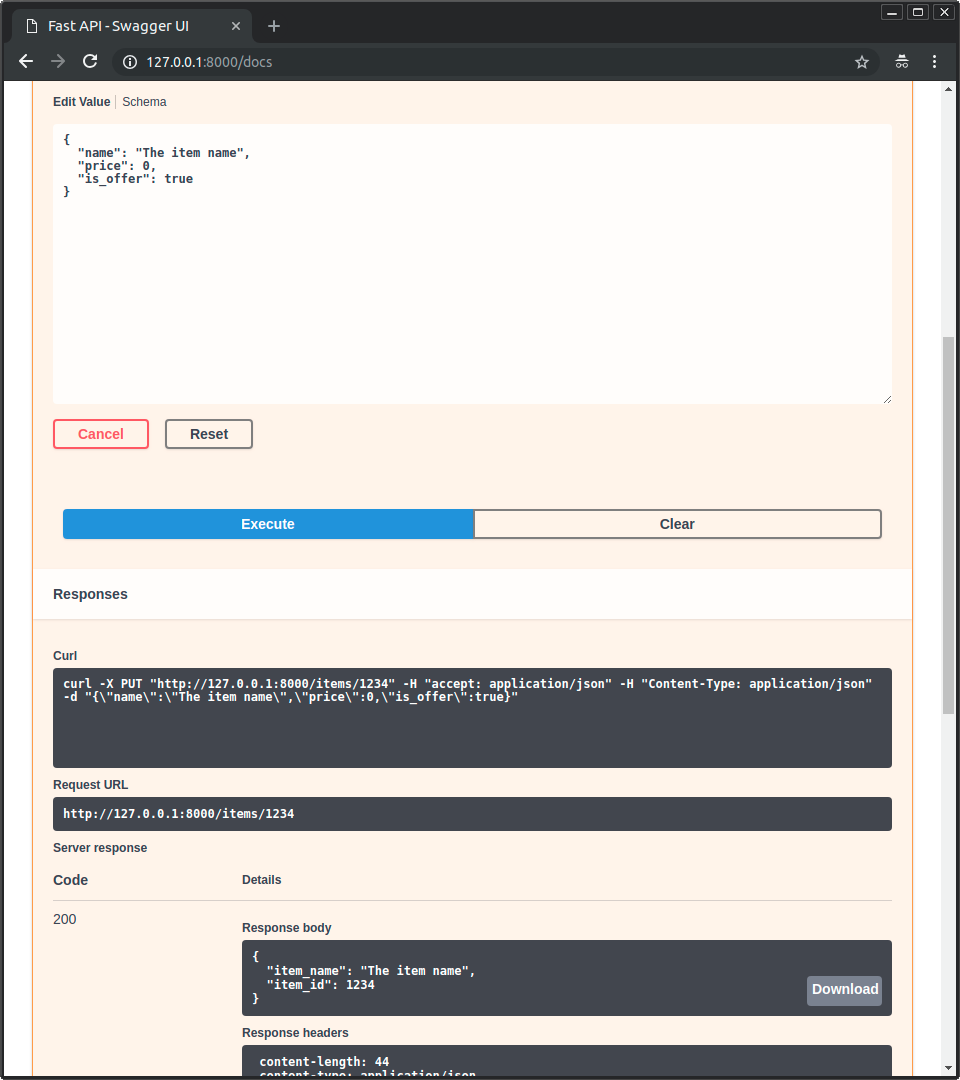 ### Alternative API docs upgrade And now, go to http://127.0.0.1:8000/redoc. * The alternative documentation will also reflect the new query parameter and body: 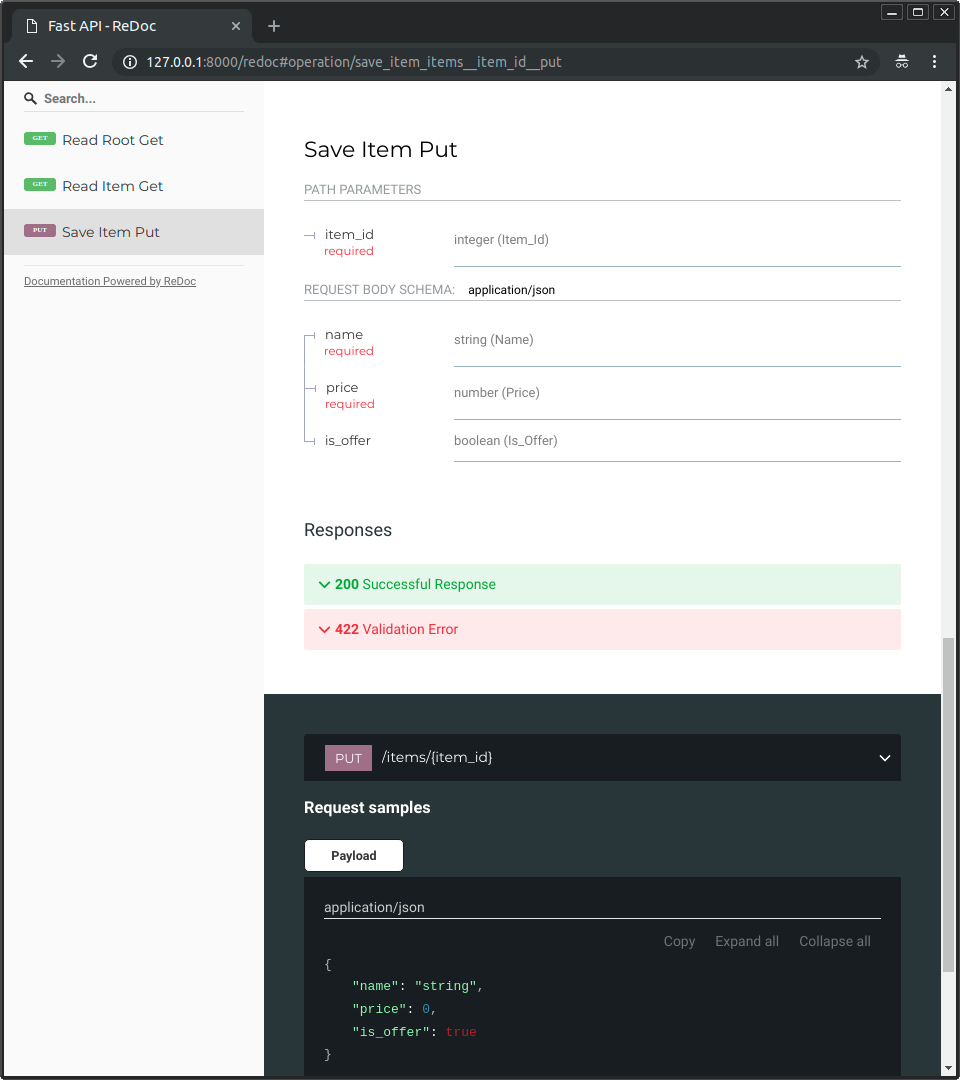 ### Recap In summary, you declare **once** the types of parameters, body, etc. as function parameters. You do that with standard modern Python types. You don't have to learn a new syntax, the methods or classes of a specific library, etc. Just standard **Python 3.6+**. For example, for an `int`: ```Python item_id: int ``` or for a more complex `Item` model: ```Python item: Item ``` ...and with that single declaration you get: * Editor support, including: * Completion. * Type checks. * Validation of data: * Automatic and clear errors when the data is invalid. * Validation even for deeply nested JSON objects. * Conversion of input data: coming from the network, to Python data and types. Reading from: * JSON. * Path parameters. * Query parameters. * Cookies. * Headers. * Forms. * Files. * Conversion of output data: converting from Python data and types to network data (as JSON): * Convert Python types (`str`, `int`, `float`, `bool`, `list`, etc). * `datetime` objects. * `UUID` objects. * Database models. * ...and many more. * Automatic interactive API documentation, including 2 alternative user interfaces: * Swagger UI. * ReDoc. --- Coming back to the previous code example, **FastAPI** will: * Validate that there is an `item_id` in the path. * Validate that the `item_id` is of type `int`. * If it is not, the client will see a useful, clear error. * Check if there is an optional query parameter named `q` (as in `http://127.0.0.1:8000/items/foo?q=somequery`). * As the `q` parameter is declared with `= None`, it is optional. * Without the `None` it would be required (as is the body). * Read the body as JSON: * Check that it has a required attribute `name` that should be a `str`. * Check that is has a required attribute `price` that has to be a `float`. * Check that it has an optional attribute `is_offer`, that should be a `bool`, if present. * All this would also work for deeply nested JSON objects. * Convert from and to JSON automatically. * Document everything as an OpenAPI schema, that can be used by: * Interactive documentation sytems. * Automatic client code generation systems, for many languages. * Provide 2 interactive documentation web interfaces directly. --- We just scratched the surface, but you already get the idea of how it all works. Try changing the line with: ```Python return {"item_name": item.name, "item_id": item_id, "query": q} ``` ...from: ```Python ... "item_name": item.name ... ``` ...to: ```Python ... "item_price": item.price ... ``` ...and see how your editor will auto-complete the attributes and know their types: 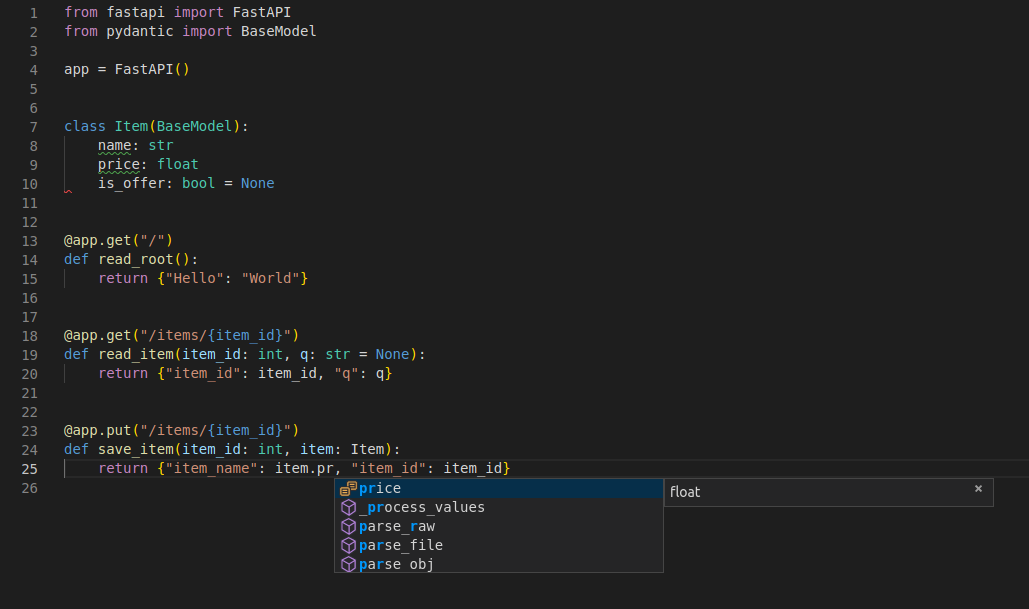 For a more complete example including more features, [see the tutorial - user guide](tutorial/intro/). **Spoiler alert**: the tutorial - user guide includes: * Declaration of **parameters** from other different places as: **headers**, **cookies**, **form fields** and **files**. * How to set **validation constrains** as `maximum_length` or `regex`. * A very powerful and easy to use **Dependency Injection** system. * Security and authentication, including support for **OAuth2** with **JWT tokens** and **HTTP Basic** auth. * More advanced (but equally easy) techniques for declaring **deeply nested JSON models** (thanks to Pydantic). * Many extra features (thanks to Starlette) as: * **WebSockets** * **GraphQL** * extremely easy tests based on `requests` and `pytest` * **CORS** * **Cookie Sessions** * ...and more. ## Optional Dependencies Used by Pydantic: *ujson - for faster JSON "parsing".
* email_validator - for email validation.
Used by Starlette:
* requests - Required if you want to use the `TestClient`.
* aiofiles - Required if you want to use `FileResponse` or `StaticFiles`.
* jinja2 - Required if you want to use the default template configuration.
* python-multipart - Required if you want to support form "parsing", with `request.form()`.
* itsdangerous - Required for `SessionMiddleware` support.
* pyyaml - Required for `SchemaGenerator` support.
* graphene - Required for `GraphQLApp` support.
* ujson - Required if you want to use `UJSONResponse`.
Used by FastAPI / Starlette:
* uvicorn - for the server that loads and serves your application.
You can install all of these with `pip3 install fastapi[full]`.
## License
This project is licensed under the terms of the MIT license.